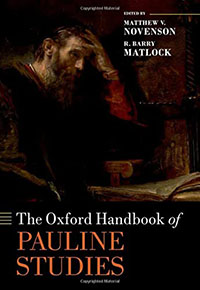Review: The Oxford Handbook of Pauline Studies
The Oxford Handbook of Pauline Studies
By Matthew Novenson and Barry Matlock, editors (Oxford University Press)
The Oxford Handbook of Pauline Studies is a comprehensive summary of the many facets of early 21st-century academic study of the apostle Paul and his influences. The fact the summary is a book of nearly 800 pages tells the breadth and depth of Pauline studies.
 The Handbook is composed of five parts: Paul the Person, Paul in Context, Pauline Literature (both inside and outside the Protestant canon of Scripture), Pauline Theology and Approaches to Paul. Articles address Paul’s history and the cultures he navigated; the early church; the composition and nature of Paul’s letters; Paul’s view of Christ, salvation, grace and justification; and contemporary topics such as politics, sexuality and gender.
The Handbook is composed of five parts: Paul the Person, Paul in Context, Pauline Literature (both inside and outside the Protestant canon of Scripture), Pauline Theology and Approaches to Paul. Articles address Paul’s history and the cultures he navigated; the early church; the composition and nature of Paul’s letters; Paul’s view of Christ, salvation, grace and justification; and contemporary topics such as politics, sexuality and gender.
Many articles are accessible and illuminating to the general reader. Others are technical or pertain to specifically academic concerns. Among the 40 contributors from around the world, which interestingly do not include N.T. Wright, are two Baylor University scholars—Bruce Longenecker and Todd Still. Their respective chapters are representative of the whole.
Longenecker examines the economic system of the Graeco-Roman world—in particular, patronage—and how it impinges on Paul’s instruction to churches. His study provides valuable—if even a little speculative—context for Paul’s collection for the church in Jerusalem and his concerns about how the Corinthian church observed the Lord’s Supper.
Still, in a decidedly guild-specific article, traces the history of and significant contributors to the social-historical and social-scientific study of Paul. He notes subsequent chapters develop some of the conclusions of those two interdisciplinary studies.
Though most contributors hail from the United Kingdom and United States, of particular interest are the articles by scholars working and teaching outside the more well-established centers of Pauline studies in Western Europe and North America.
For example, Paul Trebilco, at the University of Osago in New Zealand, considers Paul’s ability to move between the contexts of Judaism and the Graeco-Roman world. This is interesting coming from a context in which Christians are trying to communicate the gospel between the English-speaking colonial context and that of the indigenous Māori in New Zealand.
“Handbook” is a misleading descriptor for a large, hardback reference book, not something one would throw in a backpack to study at a coffee shop. As such, this handbook is not the sort of resource a pastor might use to preach through 1 Corinthians, for example, but it does provide important background for all those sermons a pastor will preach on Paul’s letters.
Eric Black, executive director/publisher/editor
Baptist Standard